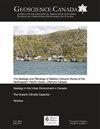A Hydrostratigraphic Framework for the Paleozoic Bedrock of Southern Ontario
IF 0.8
4区 地球科学
Q3 GEOSCIENCES, MULTIDISCIPLINARY
引用次数: 2
Abstract
Groundwater systems in the intermediate to deep subsurface of southern Ontario are poorly understood, despite their value for a number of societal uses. A regional hydrostratigraphic framework is a necessary precursor for improving our understanding of groundwater systems and enabling development of a 3-D hydrostratigraphic model to visualize these groundwater systems. This study is a compilation and integration of published and unpublished geological, hydrogeological, hydrochemical and isotopic data collected over the past 10 years to develop that framework.Bedrock is covered by a thin veneer of surficial sediments that comprise an aquifer/aquitard system of considerable local variability and complexity. Aquifers in the bedrock are thin and regionally extensive, separated by thick aquitards, within a well-defined lithostratigraphic framework and a well-developed hydrochemical depth zonation comprising a shallow fresh water regime, an intermediate brackish to saline sulphur water regime, and a deep brine regime of ancient, evaporated seawater. Occurrence and movement of groundwater in shallow bedrock is principally controlled by modern (Quaternary) karstic dissolution of subcropping carbonate and evaporite rocks, and in the intermediate to deep subsurface by paleokarst horizons developed during the Paleozoic. Flow directions in the surficial sediments of the shallow groundwater regime are down-gradient from topographic highs and down the regional dip of bedrock formations in the intermediate regime. Shallow karst is the entry point for groundwater penetration into the intermediate regime, with paleo-recharge by glacial meltwater and limited recent recharge by meteoric water at subcrop edges, and down-dip hydraulic gradients in confined aquifers. Hydraulic gradient is up-dip in the deep brine regime, at least for the Guelph Aquifer and the Cambrian Aquifer, with no isotopic or hydrochemical evidence of infiltration of meteoric water and no discharge to the surface.Fourteen bedrock hydrostratigraphic units are proposed, and one unit comprising all the surficial sediments. Assignment of lithostratigraphic units as hydrostratigraphic units is based principally on hydrogeological characteristics of Paleozoic bedrock formations in the intermediate to deep groundwater regimes, below the influence of modern meteoric water. Carbonate and evaporite rocks which form aquitards in the subsurface may form aquifers at or near the surface, due to karstic dissolution by acidic meteoric water, necessitating compromises in assignment of hydrostratigraphic units.安大略省南部古生代基岩的水文地层格架
尽管地下水系统在社会上有许多用途,但人们对安大略省南部中深地下的地下水系统知之甚少。区域水文地层学框架是提高我们对地下水系统的理解和开发三维水文地层学模型以可视化这些地下水系统的必要前提。这项研究汇编和整合了过去10年来收集的已发表和未发表的地质、水文地质、水化学和同位素数据,以发展这一框架。基岩被一层薄薄的表层沉积物覆盖,这些沉积物构成了一个具有相当大的局部变异性和复杂性的含水层/含水层系统。基岩中的含水层很薄,在区域范围很广,被厚的含水层隔开,在一个明确的岩石地层格架和一个发育良好的水化学深度带内,包括浅淡水区、中间半咸淡水到含盐硫水区和古代蒸发海水的深盐水区。浅层基岩中地下水的赋存和运移主要受下层碳酸盐岩和蒸发岩的现代(第四纪)岩溶溶蚀作用的控制,而在中深地下则受古生代发育的古岩溶层的控制。浅层地下水状态表层沉积物的流动方向是地形高点向下倾斜,中间状态是基岩地层的区域倾角向下倾斜。浅层喀斯特是地下水进入中间状态的入口,在次作物边缘有冰川融水的古补给和有限的近期降水补给,在承压含水层有向下倾斜的水力梯度。至少在圭尔夫含水层和寒武纪含水层中,深层盐水的水力梯度是向上倾斜的,没有同位素或水化学证据表明大气水渗透,也没有向地表排放。提出了14个基岩水文地层单元,其中一个单元包括所有地表沉积物。岩石地层单位作为水文地层单位的划分主要基于中深地下水中古生代基岩地层的水文地质特征,不受现代大气水的影响。在地下形成含水层的碳酸盐和蒸发岩,由于酸性大气水的岩溶溶解,可能在地表或近地表形成含水层,这就需要在水文地层单位的分配上妥协。
本文章由计算机程序翻译,如有差异,请以英文原文为准。
求助全文
约1分钟内获得全文
求助全文
来源期刊

Geoscience Canada
地学-地球科学综合
CiteScore
3.30
自引率
0.00%
发文量
9
审稿时长
>12 weeks
期刊介绍:
Established in 1974, Geoscience Canada is the main technical publication of the Geological Association of Canada (GAC). We are a quarterly journal that emphasizes diversity of material, and also the presentation of informative technical articles that can be understood not only by specialist research workers, but by non-specialists in other branches of the Earth Sciences. We aim to be a journal that you want to read, and which will leave you better informed, rather than more confused.
 求助内容:
求助内容: 应助结果提醒方式:
应助结果提醒方式:


